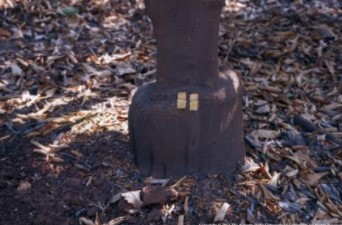
Bud union, UC ANR
In citrus, if hardier growth (such as twigs or wood) has not been seriously damaged, it is normal for dead leaves to be rapidly shed. If the frost-killed leaves remain on the plant, this is an indication that twigs or branches have been seriously damaged. If larger branches or the trunk of a tree sustain cold damage, the bark will split and dead patches of curled, dry bark may appear. If a young citrus tree has been killed nearly to the ground, inspect it closely to determine if the damage extends below the union. The union is the junction where the fruit-producing part of the tree was grafted onto the rootstock. If new growth comes only from the rootstock, the tree will no longer be true to the type you originally planted and will usually be unproductive. In this case, the tree should be replaced.
The only thing that should be done immediately after frost damage has occurred to citrus and other woody plants is whitewashing. Whitewash should be applied to the trunk and exposed limbs. This protects the bark from sunburn, which is more likely to occur if a plant becomes defoliated. Frost-damaged plants are more susceptible to disease and insects, and sunburn increases this susceptibility. To make whitewash, mix equal parts of white interior latex paint with water. If the area to be painted is particularly rough and fissured, a thinner mixture can be applied for better penetration and coverage.
Citrus leaves killed by frost, UC IMP Program
It is also important to note that frost-damaged plants are unbalanced: although their leaves have been reduced, they still have the same root system. This can result in extensive new growth over the entire plant.
To ensure that the plant reaches an acceptable balance between its leaves and its root system, the new shoots should grow at a moderate rate. It is recommended that little or no fertilizer be applied to these plants initially, and they should be irrigated less than usual until they have returned to a normal appearance. Too much nitrogen fertilizer, for example, can encourage sucker and water sprout growth, while too much water can damage roots.
Source : ucanr.edu